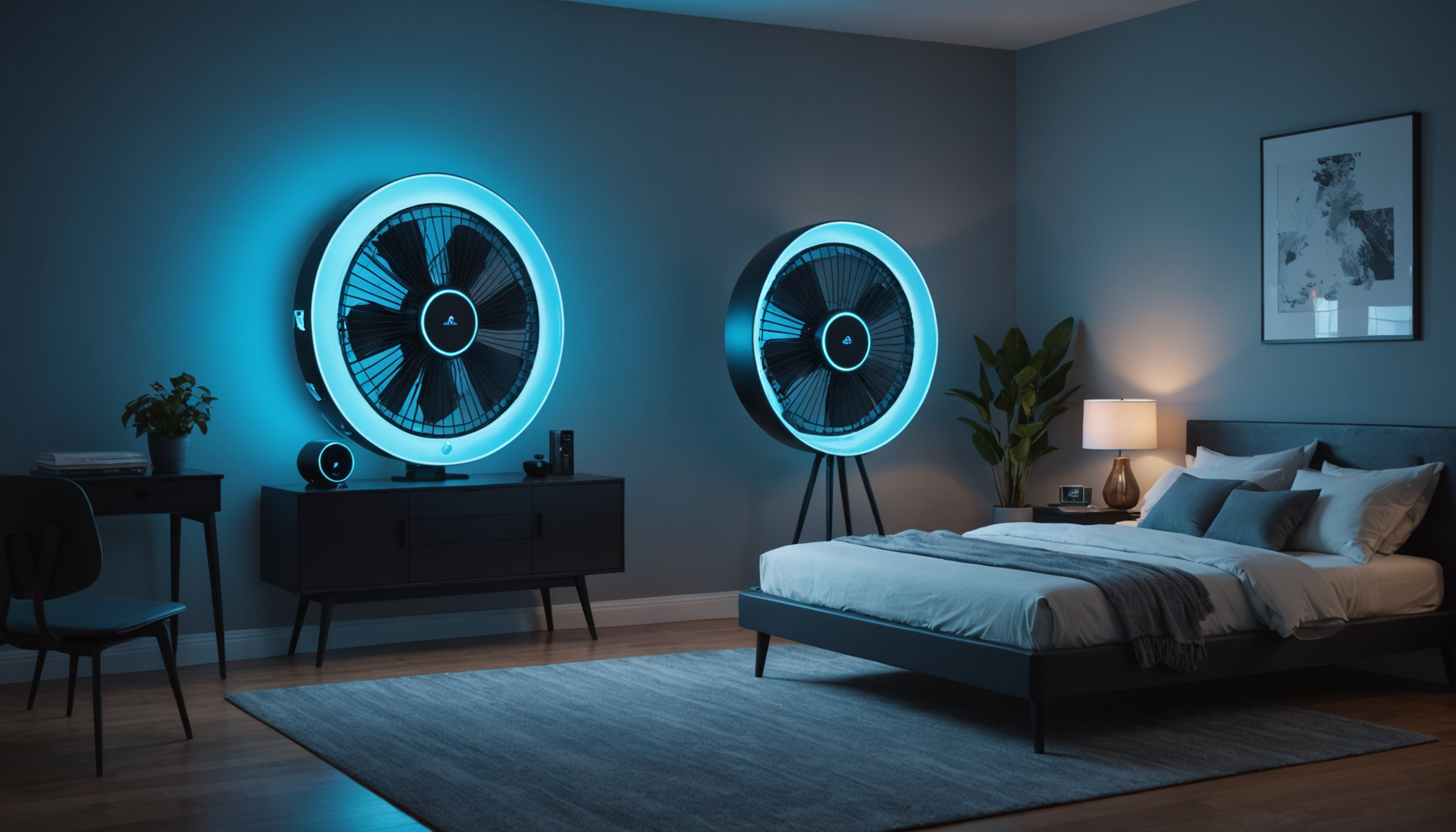As technology continues to penetrate every facet of our living spaces, smart fans are at the forefront of innovation, transforming how we perceive comfort and convenience in our homes. The latest advancements in smart fan technology are making these devices more intuitive and efficient than ever before, offering a seamless blend of functionality and connectivity that enhances user experience.
One of the most significant breakthroughs in smart fan technology is the integration of artificial intelligence and machine learning algorithms. These intelligent systems learn and adapt to a consumer’s preferences over time, adjusting fan settings autonomously to create the ideal environment. For instance, by analyzing patterns in room occupancy and temperature changes, a smart fan can predict the optimal times to operate or switch off, thus maximizing comfort while minimizing energy consumption.
Moreover, sensors play a critical role in this evolution, enabling smart fans to monitor various environmental parameters such as temperature, humidity, and air quality. The data collected by these sensors allow the fan to make real-time adjustments. For example, when humidity levels rise, a smart fan can automatically increase its speed to enhance airflow and reduce moisture levels in the room, contributing to a healthier indoor climate.
Voice control compatibility is another cutting-edge advancement reshaping the smart fan landscape. Integration with popular voice assistants like Alexa, Google Assistant, and Siri provides users with the convenience of controlling their fans hands-free. Simple voice commands can adjust speed settings, switch the fan on or off, and even schedule operation times, making these fans incredibly user-friendly.
Wireless connectivity extends beyond voice control, with many smart fans now equipped with Wi-Fi and Bluetooth capabilities. This connectivity not only simplifies installation but also facilitates remote control via smartphone applications, allowing users to manage their home environment from virtually anywhere. Beyond basic adjustments, these apps often provide detailed insights into usage patterns, assisting users in making informed decisions about their energy consumption.
Furthermore, the advent of smart programmable features enables users to schedule fan functions according to their daily routines. These programmable settings can include customized airflow modes, night settings, and even synchronization with other smart home devices. As a result, users enjoy a holistic and harmonized smart home experience that caters to their specific lifestyle needs.
| Feature | Description |
| AI & Machine Learning | Enables fans to learn user preferences and adjust operation automatically. |
| Environmental Sensors | Monitor temperature, humidity, and air quality to optimize fan performance. |
| Voice Control | Integration with voice assistants for hands-free operation. |
| Connectivity | Wi-Fi and Bluetooth options for remote control and monitoring. |
| Programmable Features | Schedule operations and automate fan settings for convenience. |
As these advancements continue to evolve, smart fans are not only becoming more intelligent but also more attuned to enhancing quality of life through personalized comfort, energy efficiency, and integration with other smart home elements. The future of climate control within our living spaces is indeed becoming smarter and savvier, offering unprecedented levels of interaction and adaptability.
integration with smart home systems
With the continued evolution of smart home ecosystems, integrating smart fans into these systems has become a pivotal aspect of their functionality. This integration not only enhances the convenience of managing home environments but also maximizes the utility of existing smart home setups. Here’s a step-by-step guide to effectively integrating smart fans with smart home systems.
1. Ensure Compatibility
Before integrating a smart fan with your existing smart home system, verify the fan’s compatibility with your ecosystem. Most smart fans are designed to work seamlessly with popular platforms such as Amazon Alexa, Google Home, and Apple HomeKit. Check the fan’s specifications to ensure it supports the desired platform for your home.
2. Connect Your Devices
Follow these steps to connect your smart fan with your smart home system:
– Amazon Alexa:
1. Open the Alexa app.
2. Navigate to “Devices” and tap on the “+” icon to add a new device.
3. Choose “Fan” and follow the instructions to link your smart fan to Alexa.
4. Once linked, Alexa can discover and control the fan using simple voice commands.
– Google Home:
1. Open the Google Home app.
2. Tap “Add” then “Set up device.”
3. Select “Works with Google” and search for your fan’s brand.
4. Sign in and follow prompts to complete the connection.
5. Test the integration with voice commands like “Hey Google, turn on the fan.”
– Apple HomeKit:
1. Ensure your iOS device is updated.
2. Open the Home app and tap the “+” icon.
3. Select “Add Accessory” and follow on-screen instructions, using your iPhone’s camera to scan the HomeKit setup code on the fan or packaging.
4. Once added, use Siri to control the fan with commands like “Hey Siri, set the fan speed to medium.”
3. Set Up Routines and Automations
Utilize your smart home system to create tailored routines and automations that enhance comfort and efficiency:
– Schedule the fan to turn on when you start your day or when the temperature reaches a certain level.
– Link your smart fan with smart thermostats to maintain optimal room conditions without over-relying on HVAC systems.
– Integrate with smart sensors to automatically adjust fan speed based on room occupancy or environmental factors like humidity.
4. Utilize Advanced Features
Explore how advanced features offered by your smart fan can be leveraged within the smart home system:
– Employ geofencing to activate the fan when you’re approaching home, ensuring a comforting environment upon arrival.
– Enable smart alerts to notify you when the fan detects unusual patterns, such as increased humidity or temperature spikes, ensuring proactive management of your home environment.
5. Maintain and Update Regularly
Regularly check for software updates for both your smart fan and home system to ensure seamless operation and security. Schedule periodic maintenance checks to uphold the optimal performance of your fan.
By integrating smart fans with smart home systems, you not only enhance the efficacy of climate control in your spaces but also cement a more cohesive and responsive home environment. This connectivity adds an element of sophistication and harmony to modern living, making everyday life more manageable and enjoyable.
energy efficiency and sustainability
In today’s environmentally conscious world, the focus on energy efficiency and sustainability has become paramount, and smart fans are leading the way in this green revolution. These advanced appliances offer a substantial reduction in energy consumption, which not only lightens the load on the household budget but also minimizes the overall carbon footprint.
Smart fans are equipped with cutting-edge technologies designed to optimize energy use. One of the primary features is the use of DC motors, which are significantly more efficient than traditional AC motors. These motors consume less electricity, translating into lower energy bills and a quieter operation, enhancing user comfort without sacrificing performance. Additionally, smart fans often incorporate variable-speed controls, allowing precise adjustments to fan speed based on real-time needs and preferences, which enhances energy efficiency.
Furthermore, the integration of smart sensors plays a crucial role in enhancing sustainability. These sensors detect changes in the environment, such as shifts in temperature or humidity levels, and automatically adjust the fan’s operation to maintain optimal comfort levels while using the least amount of energy possible. This not only makes the home environment more comfortable but also ensures that energy is not wasted when it’s not needed.
Incorporating features that support sustainability, many smart fans are designed to work in tandem with other eco-friendly devices, such as smart thermostats, ensuring that heating and cooling systems are not overutilized. This synchronization means that these appliances can work together efficiently and that the fan operates independently only when necessary, ultimately reducing reliance on energy-intensive systems.
Smart fans are also an excellent choice for those committed to sustainable living, as they often include eco-mode settings that prioritize energy conservation. These modes allow the fan to automatically adjust its operation during off-peak hours or when maximum cooling is not required, further contributing to an energetically efficient home.
Moreover, manufacturers are increasingly using sustainable materials in the construction of smart fans. From recyclable components to non-toxic paint finishes, these features are all part of a broader effort to reduce the environmental impact of manufacturing and disposal, ensuring that the fans are as eco-friendly as they are technologically advanced.
By embracing the principles of energy efficiency and sustainability, smart fans are not only enhancing the comfort and convenience of the home environment but also advancing a more environmentally friendly and cost-effective lifestyle. With these technological innovations, homeowners can enjoy significant energy savings while actively contributing to a more sustainable future.
design and aesthetic trends
The realm of smart fans has expanded far beyond functionality and efficiency, diving deeply into the realms of design and aesthetics. Modern smart fans are crafted not only as tools for comfort but also as stylish additions that can enhance the visual appeal of any space. These fans cater to diverse tastes and preferences, making it easier than ever to find a model that aligns with your personal sense of style.
One of the most noticeable trends in smart fan design is minimalism. Clean lines, smooth finishes, and unobtrusive forms define many of the latest models, helping these devices blend seamlessly with contemporary home décor. Fans crafted from materials such as brushed metal or high-gloss plastic provide a modern touch, often available in neutral colors that harmonize with a wide range of color palettes. This minimalistic approach ensures the fan is not just a functional appliance but an integral part of room design.
Conversely, there is a rising interest in smart fans that incorporate natural materials, appealing to those who prefer a warm and organic aesthetic. Fans made with real wood or wood-look finishes are especially popular, providing an inviting and soothing element to living spaces. These designs often complement traditional or rustic-themed interiors, offering a rustic charm without compromising on modern smart technologies.
Customization has also become a critical aspect of smart fan design. Many manufacturers now offer customizable features that allow consumers to choose everything from blade finishes to lighting options and control panels. This freedom ensures that the fan not only matches the room’s existing décor but also reflects the personality of the homeowner, creating a more personalized and intimate environment.
The use of LED lighting has transformed the aesthetic potential of smart fans. Many contemporary designs include integrated lighting systems that offer various color temperatures and brightness levels, allowing homeowners to adjust the ambiance according to their mood or the time of day. These lights can often be managed via smartphone apps or integrated voice control, providing powerful, adaptive illumination that enhances both the functionality and atmosphere of the space.
A key aspect of modern smart fan design is the emphasis on silent operation. Advanced motor technologies ensure that these fans remain whisper-quiet, eliminating the distraction of mechanical noise and enhancing their suitability for areas like bedrooms or living rooms, where a peaceful ambiance is paramount.
The prevailing trend of blending functionality with aesthetics in smart fan design reflects a shift toward seeing these devices not just as tools but as a statement of style and personality. As manufacturers continue to innovate, the design possibilities remain endless, offering something for every taste and ensuring that smart fans will remain a significant part of interior design well into the future. These innovations allow smart fans to transcend their traditional role, becoming vital components in creating beautiful, comfortable, and modern living environments.
future prospects and innovations
Looking at the horizon of smart fan development, the future promises to be as dynamic as it is innovative. With significant advancements already making waves, the next steps will likely focus on further enhancing personalization and integration with entire smart ecosystems.
User interfaces are expected to evolve into more sophisticated forms, embracing augmented reality (AR) and virtual reality (VR) elements for more intuitive and immersive control experiences. Imagine a virtual display projected onto a wall where users can interact with their smart fan settings via simple gestures or even using VR goggles for a 360-degree smart home command center.
Moving forward, the role of artificial intelligence in smart fans is set to deepen. Future iterations might employ advanced behavioral analytics, learning from every interaction to predictively adjust settings, anticipating users’ needs before they even express them. This could include dynamically adjusting settings based on real-time biometric data, such as body temperature or heart rate, gathered through wearable sensors, ensuring the ultimate personalized comfort.
As IoT devices continue to proliferate, interoperability will become a key trend. Smart fans will likely serve as nodes within an interconnected web of devices, seamlessly communicating with thermostats, lights, and even appliances to create holistic smart home experiences. This could also extend to smart cities, where smart fans synchronize with urban networks to contribute to public space climate control, enhancing comfort in shared environments while conserving energy at a municipal level.
Sustainability will undoubtedly remain at the forefront, with innovations targeting even more significant reductions in resource consumption. New materials that are 100% biodegradable or sourced from renewable resources might be standard, alongside enhancements in energy harvesting technology that allows smart fans to draw power from ambient sources like solar or kinetic energy.
Moreover, as climate change continues to impact global weather patterns, we may see the advent of adaptive climate control systems within smart fans, capable of analyzing external climate data and adjusting home environments proactively to prepare for impending weather changes.
Incorporating these advancements ensures that smart fans will not only fulfill their environmental comfort roles but will also actively participate in creating intelligent, responsive, and sustainable living and working spaces. As such, the ongoing evolution of smart fans heralds an exciting future where technology and everyday living intertwine more seamlessly and sustainably.
In conclusion, the evolution of smart fans signifies a remarkable journey where cutting-edge technology meets practical needs, redefining home comfort and functionality. With advancements in AI, seamless integration into smart homes, energy efficiency, sleek designs, and a promising future of ongoing innovations, smart fans are setting a high bar for intelligent home appliances. As they continue to evolve, these devices promise not only enhanced living environments but also broader contributions to sustainability and lifestyle transformations, ultimately making everyday life smarter and more efficient.


